Refrigeration
Cooling uses refrigeration which is accomplished using substances that have very low boiling points. For example Ammonia (NH4) at standard atmospheric temperature (say between 60oF and 120oF when cooling is required) and pressure (14.7 psia) is a gas. It is a refrigerant because it has a boiling point of -28oF and freezing point of -254oF at standard conditions.
So liquid ammonia at -28oF can give up it's heat (boil/evaporate into gas) when pumped through the tubes of a cooling coil to cool air and when pumped through a heat exchanger to cool water. Once it has become a gas it has to be converted back to a liquid so that it can be used again to cool again. All refrigerants are therefore gases at standard temperature and pressure. Small amounts of ammonia in it’s gaseous state will leak from the refrigerant piping system and leave strong odors in the space and building. So it is not suitable for air conditioning occupied buildings. It therefore has other uses in factory processes since it is inexpensive.
Refrigerants such R-12 (di-chloro-di-flouro-methane, CCL2F2), are odorless and were considered harmless until recently. These are called halogenated compounds (CFC) and they were the main refrigerants used for air conditioning and refrigeration until recently. Because of their great stability these products continue to exist in the atmosphere as gases for many years and eventually diffuse into the stratosphere. Once in the upper atmosphere these compounds (CFCs) break down releasing chlorine destroying ozone (ozone depletion). In the lower atmosphere they absorb infrared radiation which may contribute warming of the earth (global warming).
Substitution of a hydrogen atom for one or more of the halogens in a CFC molecule greatly reduces its atmospheric lifetime and lessens its environmental impact. Refrigerants such as R-22 (chloro-di-flouro-methane, C3H8) are called HCFCs. By international convention/protocol both CFCs and HCFCs have to be phased out because of the harm that they might do. The production of CFCs (ex. R-12) in developed countries has been stopped. The production of HCFCs (ex. R-22) have to be phased out over the next few years and banned in 2020.
The new refrigerants that are considered harmless today are called hydro-flouro-carbons or HFCs. They include R-32 (di-flouro-methane, CH2F2, methylene-fluoride), R-125 (penta-flouro-ethane, CHF2CF3), R-134a (tetra-flouro-ethane, CH2FCF3) and R-143a (tri-flouro-ethane, CF3CH3). The mixtures of these refrigerants include R-404A (R-125-44% ; R-143a-52% ; R-134a-4%), R-407C (R-32-23% ; R-125-25% ; R-134a-52%) and R-410A (R-32-50% ; R-125-50%).
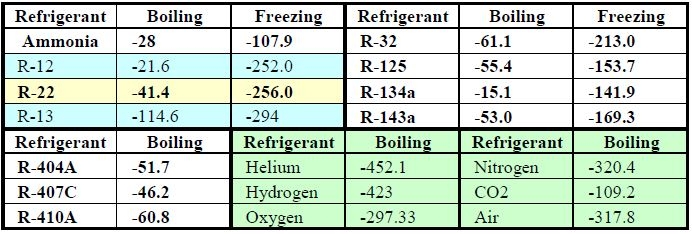
The process of cooling is called refrigeration. Refrigeration or cooling capacity is measured in tons. It was established on the basis of the heat that must be added per hour to 1 ton (2000 lbs) of ice at 32oF to melt it into water at 32oF in one day (24 hours). The heat required to melt 1 lb of ice at 32oF to water at 32oF is 144 btu.
1 Ton Refrigeration = ( 2000 lbs * 144 btu/lb ) / 24 hrs/day = 12,000 btu/hr.
Enthalpy is the energy content of a substance. It is usually expressed in heat units and in layman's terms it is referred to the heat content. For example air consists of dry air and moisture (water-vapor / steam). In English (IP) units the heat content of the air is measured from 0oF and the heat content of the water vapor is measured from 32oF which is the freezing point of water at standard pressure. So the enthalpy of dry air below 0oF is a negative value.
The enthalpy of moisture below 32oF is also negative but not a factor since most of it will have condensed and then frozen out as ice from the air. There is actually no such thing as negative heat content and it only exists theoretically because of the arbitrarily selected zero point. If heat content was measured from absolute zero temperature (0oR or -460oF) then all enthalpy values, or heat contents of substances, would be positive. In metric (SI) units the enthalpy of both the dry air and water vapor is measured from 0oC.
Example-1: What is the enthalpy of 1 lb of steam at 312oF,
measured from 0oF, at standard pressure of 14.7 psia? See Figure ?.
The heat required to melt 1 lb of Ice at 32oF to 1 lb of Water at 32oF is 145 btu.
The heat required to boil water at 212oF to Steam at 212oF is 970 btu.
The specific heat of Ice is 0.47, of Water is 1.0, and Steam is 0.45.
H1 = Ice from 0oF to 32oF = 1 lb x 0.47 SpHt x (32oF - 0oF) = 1 x 0.47 x 32 = 15 btu.
H2 = Latent Heat to melt Ice at 32oF into Water at 32oF = 1 lb x 145 = 145 btu.
H3 = Water from 32oF to 212oF = 1lb x 1.0 x (212oF - 32oF) = 1 x 1.0 x 180 = 180 btu.
H4 = Latent Heat to boil Water at 212oF into Steam at 212oF = 1 lb x 970 = 970 btu.
H5 = Steam from 212oF to 312oF = 1 lb x 0.45 SpHt x (312oF - 212oF) = 45 btu.
Enthalpy (H) = H1 + H2 + H3 + H4 + H5 = 1355 btu for 1 lb.
Example-1a: What is the enthalpy of 1 lb of steam at 312oF, measured from 32oF, at 14.7 psia?
Enthalpy (H) = H3 + H4 + H5 = 1195 btu. This is the official H of steam at 312oF
Example-2: What is the enthalpy of 1 lb of air at 95oF DB temp and 60% relative humidity (RH)? The humidity ratio (W) at 95oF and 60% RH (from psychrometric chart or tables) is 0.0218 lbs of moisture per lb of dry air. The specific heat (SpHt) of dry air = 0.24, water = 1, steam = 0.45. H = M *SpHt* (T2 - T1). Latent heat evaporation water to steam at 95oF (-14 psig) = 1040 btu/lb.
M (moisture) = 0.0218 lbs/lb M (dry air) = 1 - 0.0218 = 0.9782
H (dry air) = 0.9782 * 0.24 * (95 – 0) = 22.3.
H (water) = 0.0218 * 1 * (95 -32) = 1,37. H (water to steam) = 0.0218 * 1040 = 22.6.
H (moisture) = 1.37 + 22.6 = 23.97.
H (dry air and moisture) = 22.3 + 23.97 = 46.27 btu/lb of air.
Work
Work measurement was established arbitrarily and by tradition in the same way as length, weight, time, heat, temperature and pressure. In I-P units a unit of work is done when 1 lb mass is lifted vertically against gravity through a distance of 1 foot. The unit is called foot-pound (ft-lb). Similarly, when 1 kilogram mass is lifted vertically against gravity through a distance of 1 meter then the work done is 1 kilogram-meter.
1 lb weight resting on a surface area of 1 square foot exerts a pressure or force of 1 lb per square foot. Supposing the surface area of the soles of a person’s two feet is 1 square foot (each foot being 12 inches by 6 inches) and the person weighs 100 lbs then the person exerts a force of 100 lbs/ft2 on the ground. If you lift this person off the ground by 1 foot then you have done 100 ft-lbs of work. Work done is Force x Distance.
Force is pressure per unit area. In Figure ?? force, behind a piston, is applied to a gas in a cylinder, moving the cylinder a certain distance and compressing the gas. So work has been done. Figure ?? shows that the work done is the area under the curve from pressure-volume condition 1 to pressure-volume condition 2. The process is not usually a straight line.

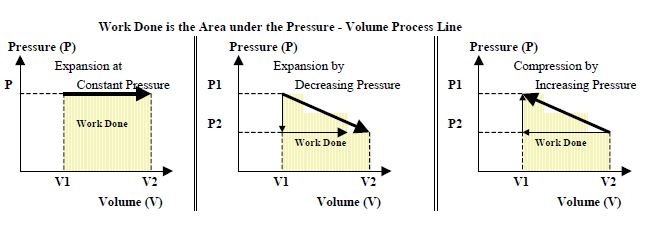
Laws of Thermodynamics
The principal energy laws are derived from two famous laws of thermodynamics. The two principal laws of thermodynamics apply only to closed systems, that is, entities with which there can be no exchange of energy, information, or material. The universe in its totality might be considered a closed system of this type; this would allow the two laws to be applied to it.
The first law of thermodynamics says that the total quantity of energy in the universe remains constant. This is the principle of the conservation of energy. The second law of thermodynamics states that the quality of this energy is degraded irreversibly. This is the principle of the degradation of energy. The first principle establishes the equivalence of the different forms of energy (radiant, chemical, physical, electrical, and thermal), the possibility of transformation from one form to another. This first principle considers heat and energy as of the same physical nature
In fact physical, chemical, and electrical energy can be completely changed into heat. But the reverse (heat into physical energy, for example) cannot be fully accomplished without outside help or without an inevitable loss of energy in the form of irretrievable heat. This does not mean that the energy is destroyed; it means that it becomes unavailable for producing work. The irreversible increase of this non disposable energy in the universe is measured by the abstract dimension that Clausius in 1865 called entropy (from the Greek entrope, change).
Entropy
The ASHRAE tables from which the information in Table ? and Figure ? were extracted also shows the "entropy" of water and steam under varying temperatures and pressures. The concept of "entropy" is very useful in investigating and understanding heat gained and lost during mechanical and combustion processes. It can be used to compare and understand the performance of different types of fuels and refrigerants in mechanical (engine) operations. Entropy relates heat received and rejected with temperature changes. The symbol for entropy is the letter 'S'. The area under the process curve on a temperature - entropy chart represents the heat received or rejected as shown in the figure below.
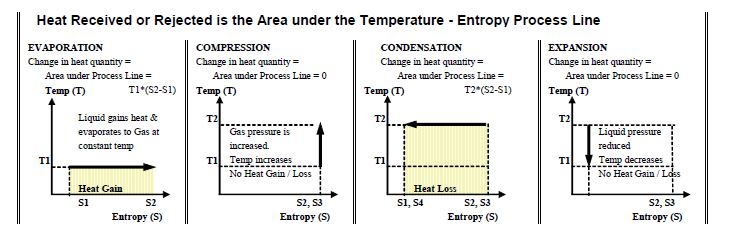
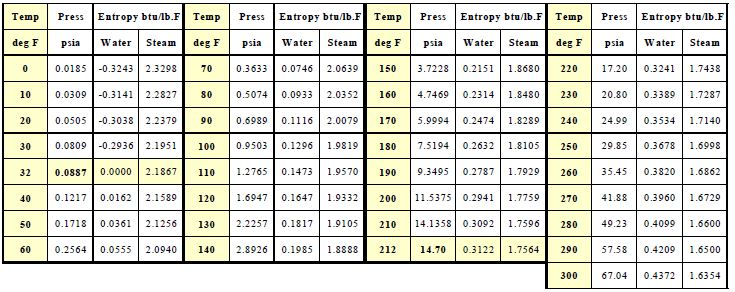
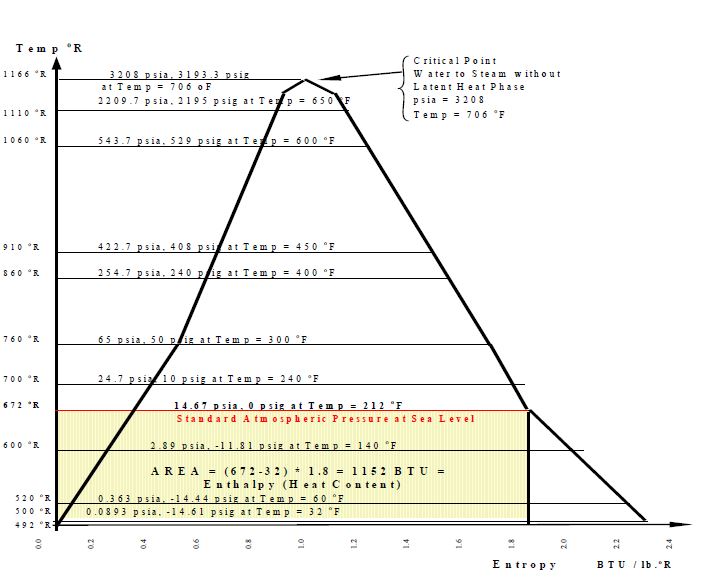

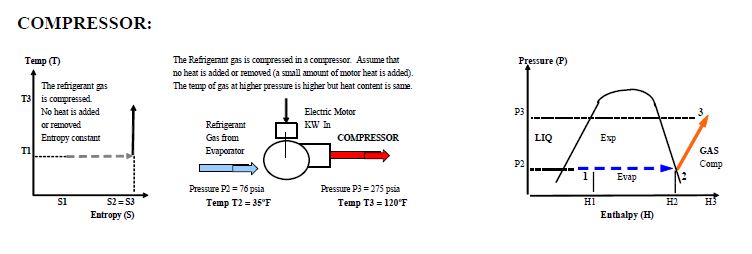


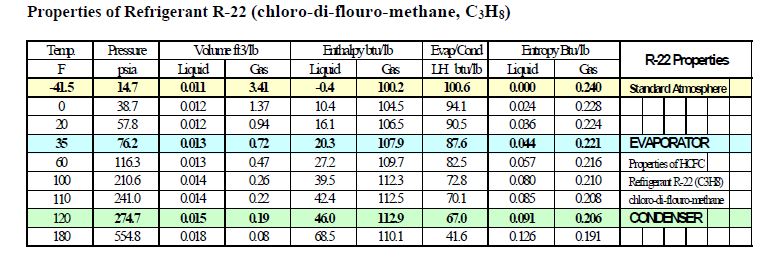
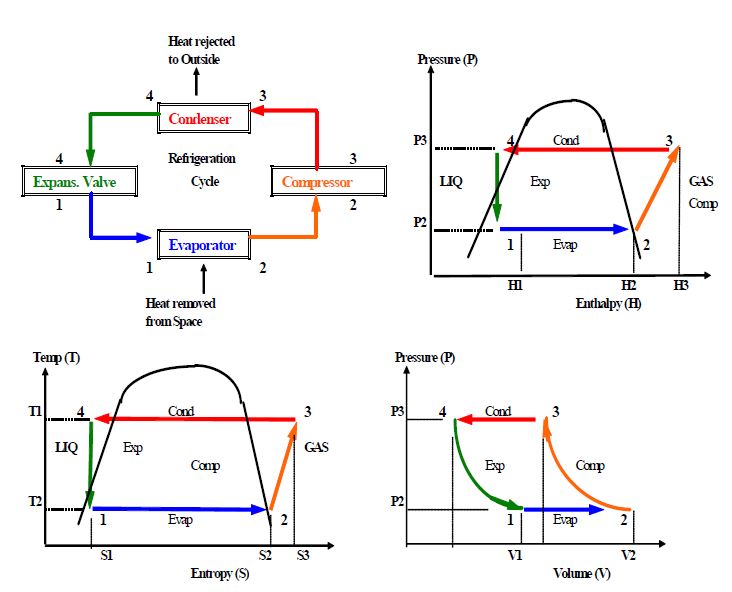
Air Source Heat Pump
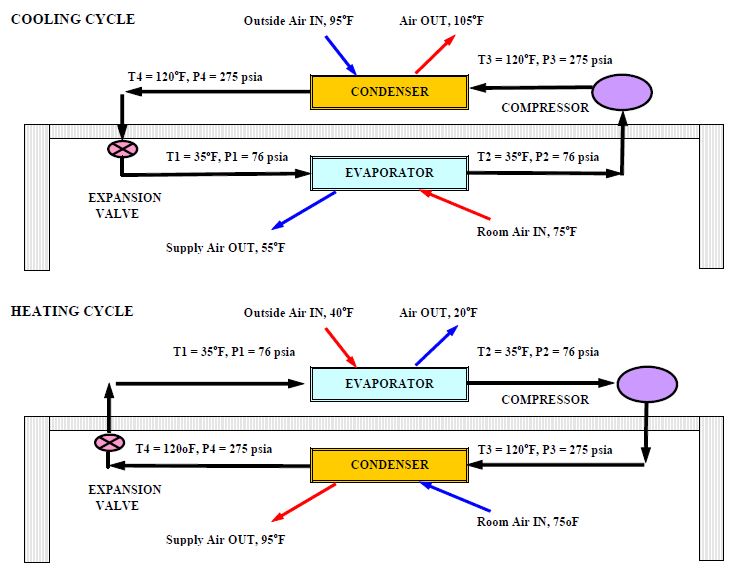
In summer, an air-conditioning (refrigeration) system picks up heat from a space where it is not needed and rejects it to the outdoors. The space gives up its heat to a refrigerant such as R-22 (low boiling point of -41oF at normal atmospheric conditions) which evaporates from liquid to gas by absorbing the heat from the room air which is passed over it. The gas is compressed to a pressure where it's temperature is greater than the hot outside air temperature. The outside air is then used to cool the gas back to liquid. So the refrigerant transfers heat from the inside to the outside. Expansion of the liquid refrigerant at high temperature and pressure converts it back to low temperature and pressure which completes the cycle.
The principle of refrigeration is that the boiling point of liquids increases with increasing pressure. So hot outside air can be used to cool the refrigerant if the pressure is high enough. Work (using a compressor driven by an electric motor) has to be done to compress the gas and increase it's pressure. In winter the refrigeration cycle can be reversed. Cold outside air is cooled (from say, 30oF to 10oF in the condenser which now becomes the evaporator) and the rejected heat is used to heat the inside air (from say 75oF to 95oF in the evaporator which now becomes the condenser). The properties of R-22 is suitable for "reverse cycle" heating provided the winter temperatures are mild (above 20oF) and annual heating hours are small. Electric resistance heating is more efficient than using compressors driven by electric motors.
Chiller Plant
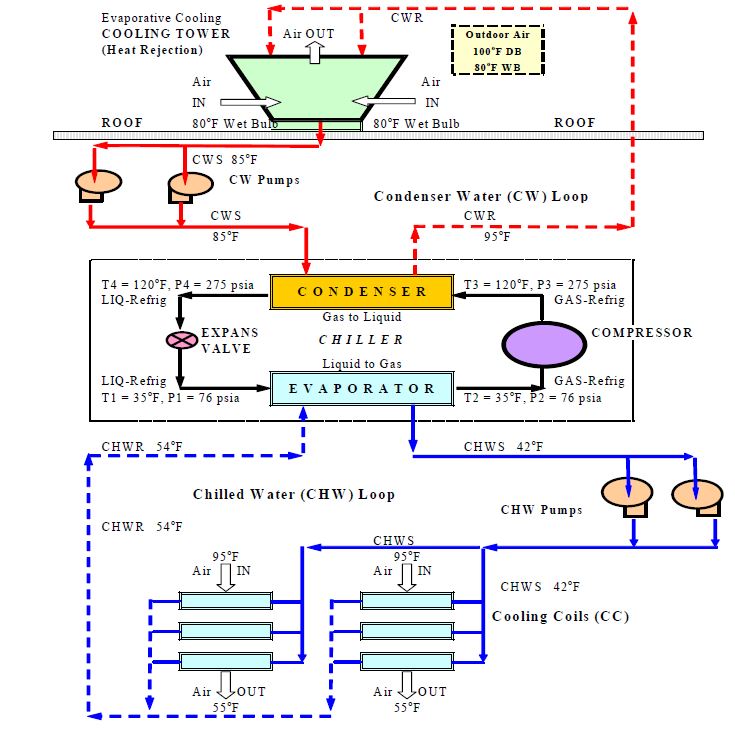

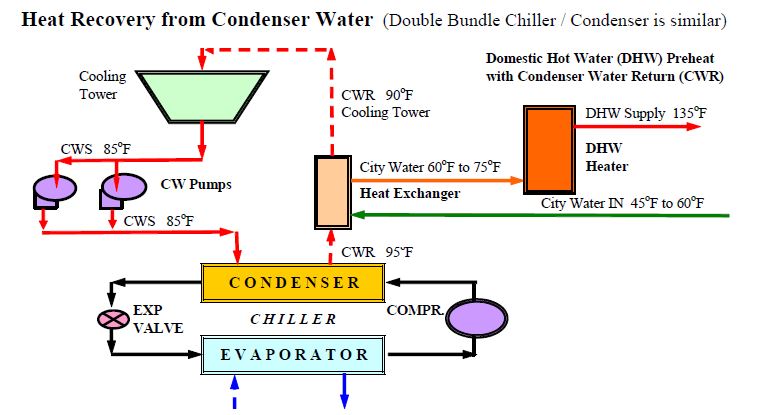
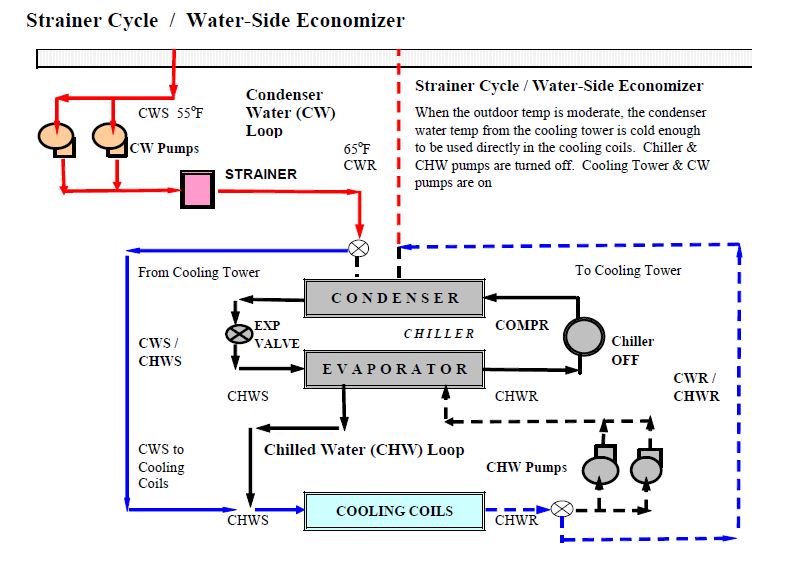
Ground Loop Heat Pump (GLHP)
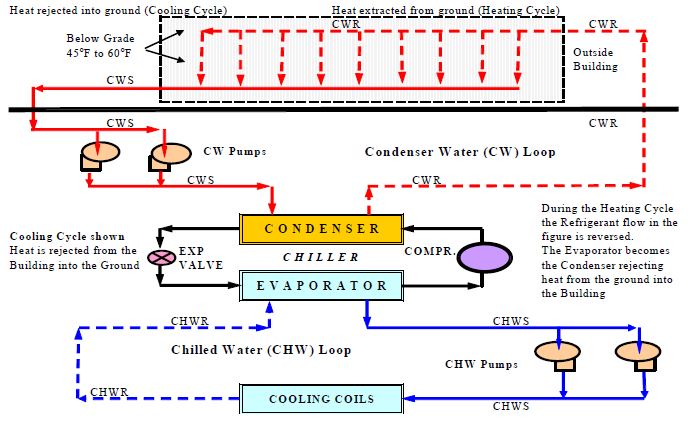
Ground Source Heat Pump (GSHP)
This is similar to the Ground Loop Heat Pump (GLHP) except that the water from the ground is pumped out to cool the refrigerant in the condenser. The ground water leaving the condenser is then rejected into the ground (discarded). The GLHP is a closed loop circulating the same water (some water is lost and has to be made up) through the piping system and remains clean. The GSHP system water exchanges heat with the ground through the piping surfaces. The water does not come into contact with the ground. Ground water has to be cleaned (strained and treated chemically and biologically) before it can pass through the condenser and piping system. GSHP is therefore more efficient than GLHP but the maintenance costs are higher
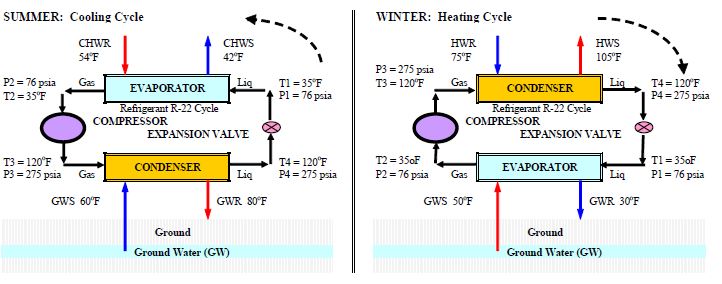
Water Source Heat Pumps (WSHP)
The water source heat pump system is a heat recovery system. In winter the heat rejected from interior space cooling loads of an office building can be used to heat perimeter spaces that require heating. In hotels and apartment buildings where some rooms require heating and others require cooling, the heat rejected from the cooling units provides heat for rooms requiring heating. The WSHP system therefore provides simultaneous and flexible cooling and heating to each room
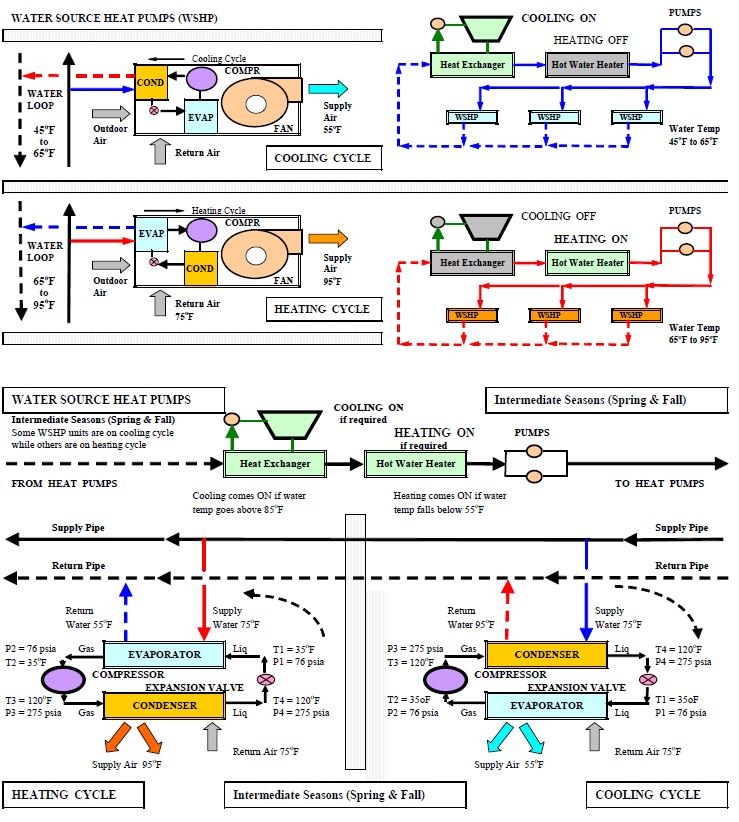
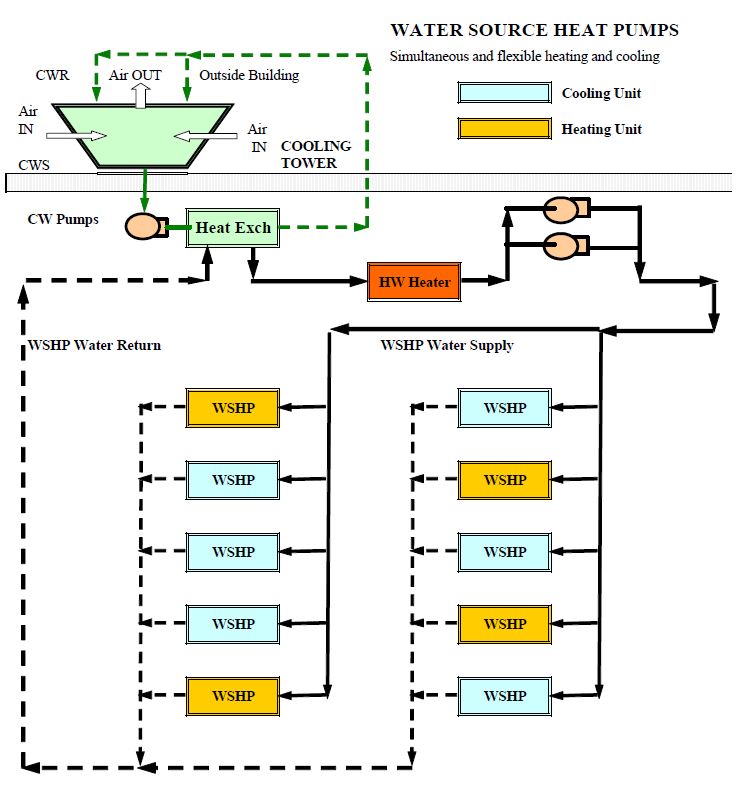
Absorption Water Chillers (based on Trane literature)
Both vapor-compression and absorption refrigeration cycles accomplish cooling by absorbing heat from one fluid (chilled water in the evaporator) and transferring it to another fluid (cooling tower water in the condenser or directly to the ambient air). The fluid that absorbs heat in the evaporator and discharges it in the condenser is called the refrigerant. Both cycles also include devices to increase and decrease the pressure of the refrigerant. Both cycles include an evaporator, condenser and expansion device. The compressor in the vapor-compression system is replaced by an absorber, generator and pump in the absorption system and there is a secondary fluid (besides the refrigerant) called the absorbent.

The refrigerant in the form of liquid (and some vapor) enters the evaporator and absorbs heat from the chilled water (cools it say from 54oF to 42oF) and boils or evaporates. The absorption action of the absorber/absorbent sucks in the refrigerant vapor. The pump sucks in the mixture of absorbent and refrigerant and pumps/pushes (acts like a compressor increasing the pressure of the refrigerant) it through the generator and generator. So the absorber intake is equivalent to the suction side of the compressor and generator discharge is equivalent to the compressor discharge.
The refrigerant vapor at higher pressure enters the condenser where it is cooled to liquid by the condenser (the condenser water absorbs the heat from the refrigerant increasing it's temperature from say, 85o to 95oF). The liquid refrigerant then flows through the expansion valve reducing it's pressure and temperature and it can be used again to chill the chilled water.
The refrigerant commonly used in the absorption cycle is distilled water. Distilled water is stable, low in cost, readily available, environmentally friendly and has a high heat of vaporization (approximately 1000 btu per lb to convert it from water to steam). For the water to operate as a refrigerant, the cycle must operate in a vacuum, that is at a pressure below atmospheric pressure.
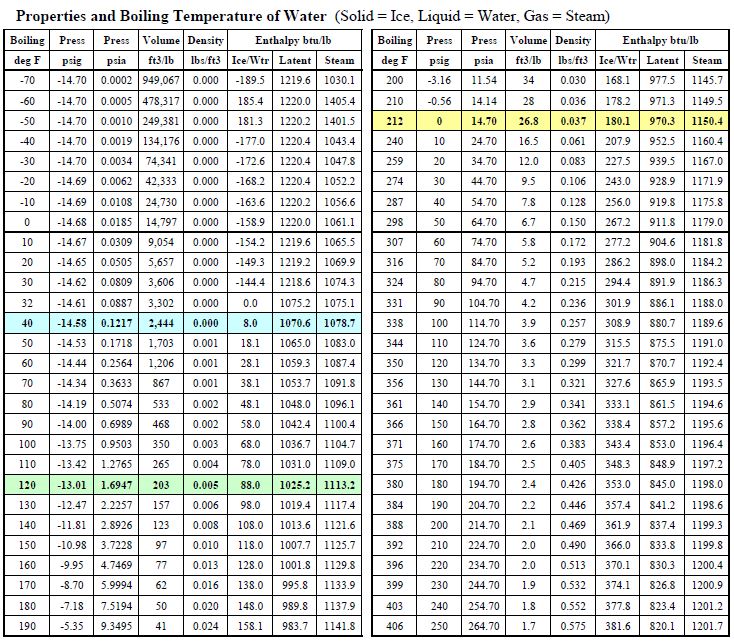
The absorption refrigeration cycle uses a second fluid called the absorbent solution. An example of an absorbent is Lithium Bromide (LiBr). LiBr is non-toxic, readily available and inexpensive. This solution is confined to the absorber and generator sections of the cycle. It is used to move the refrigerant (distilled water) from low pressure to high pressure.
The absorbent (LiBr) should have a strong affinity to absorb the refrigerant (H2O). The solution of absorbent and refrigerant should have a boiling point that is much higher than the refrigerant (water) alone. This makes it easy to separate the absorbent from the refrigerant at high temperatures. A pump is used to circulate the absorbent-refrigerant solution between the absorber and generator. The pump also increases the pressure.
Another common refrigerant-absorbent combination is ammonia as the refrigerant and water as the absorbent. This combination is sometimes used in small residential application. This discussion assumes the refrigerant is Distilled Water (H2O) and the absorbent is Lithium Bromide (LiBr).
The two fluids, refrigerant and absorbent, are mixed inside the chiller in various concentrations. The term "dilute solution" refers to a mixture that is high in refrigerant (H2)) and low in absorbent (LiBr). "Concentrated solution" refers to a mixture that is low in H2O and high in LiBr. "Intermediate solution" is somewhere in between.
The components of the absorption refrigeration cycle are the evaporator-absorber on the low pressure side and the generator-condenser on the high pressure side. The pressure on the high pressure side is about ten times the low pressure side.
The Absorption Refrigeration Cycle
Generator: Starting on the high-pressure side of the cycle, the purpose of the generator is to deliver the refrigerant vapor (water/steam) through the rest of the system cycle. It accomplishes this by separating the water/steam refrigerant from the lithium-bromide (LiBr) and water (H2O) solution. This is done by increasing the temperature of the solution using a steam or hot-water coil. The refrigerant vaporizes and separates from the LiBr which remains a liquid at this higher temperature. The steam is at 120oF and 1.7 psia (below atmospheric pressure of 14.67 psia). The concentrated LiBr is returned to the absorber.
Condenser: The refrigerant (steam) at 120oF and 1.7 psia is condensed to water (refrigerant) at 120oF and 1.7 psia using condenser water that enters at 85oF and leaves at 95oF. The leaving condenser water is cooled by an evaporative cooling tower. (Similar to Compression Chillers).
Expansion Valve: The liquid refrigerant water at 120oF and 1.7 psia is allowed to expand through an expansion device that lowers it's pressure to 0.122 psia. At this pressure the temperature of the water is 40oF. (Similar to Compression Chillers).
Evaporator: The refrigerant (water) at 40oF and 0.122 psia is evaporated to steam (refrigerant) at 40oF and 0.122 psia by chilled water that enters at 54oF, rejects it's heat to the refrigerant (absorbs heat and boils) and leaves at 42oF. The chilled water at 42oF is supplied to cooling coils that cools the space supply air down to 47oF to 55oF. (Similar to Compression Chillers).
Absorber: Inside the absorber, the refrigerant vapor (steam, H2O) at 40oF and 0.122 psia is absorbed by the concentrated lithium bromide (LiBr). As the vapor (steam) is absorbed by the LiBr it condenses from vapor to liquid (water) and forms a dilute solution of LiBr and H2O. Absorption cools, just as in evaporative cooling where warm air is cooled by absorbing moisture from a spray of water. So some of the heat gained by the refrigerant from the chilled water in the evaporator is rejected. Absorption of the refrigerant by LiBr creates a low pressure within the absorber and this also induces a continuous flow (suction) of refrigerant from the evaporator. The dilute liquid solution of LiBr and H2O leaves the absorber at 40oF and 0.122 psia.
Pump: The dilute LiBr and H2O liquid solution is pumped to the generator. This increases the pressure from 0.122 psia to 1.7 psia and the corresponding temperatures at these pressures are 40oF and 120oF.
Applications of Absorption Chillers
Where low cost fossil fuel is available. The fossil fuel used to create steam that separates the lithium bromide and water at 1.7 psia and 120oF is natural gas or diesel fuel.
Where the electric rates are very high compared to the cost of generating steam from fossil fuel. For example, the peak electric demand and energy rates are 3 times more compared to off-peak rates and the building is occupied mainly during the peak rate hours (9 AM to 5 PM).
It is more cost effective to use the steam boiler for winter heating for summer cooling also.
When waste heat in the form of steam from a cogeneration (CoGen) plant is available. This waste heat can be up to 70% of the fossil fuel used to generate electricity. This happens when a building (usually several buildings as on a university campus) has it's own electricity generating plant and the waste heat is used to create chilled water at a central plant site and distributed to the buildings. If there is a power plant near a city (New York, Boston, Minneapolis) then the waste heat is distributed to the buildings in the form of chilled water (CHW), steam and high temperature high pressure hot water (HTHW) by the power company. If the power plant is far from the city then the cost of bringing the steam, CHW and HTHW using piping is prohibitive.
When there is a lack of electric facilities near the building site as in rural areas. An absorption chiller only uses about 3% of the power by compression chillers. This power can be generated by micro-generators similar to those used for back-up emergency power.
The absorption machine can be installed in practically any location in the building. There are no heavy moving vibrating parts and the noise generation is low compared to compression chillers
